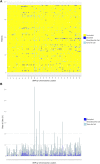Genotyping concordance in DNA extracted from formalin-fixed paraffin embedded (FFPE) breast tumor and whole blood for pharmacogenetic analyses
- PMID: 26276228
- PMCID: PMC4624024
- DOI: 10.1016/j.molonc.2015.07.002
Genotyping concordance in DNA extracted from formalin-fixed paraffin embedded (FFPE) breast tumor and whole blood for pharmacogenetic analyses
Abstract
Background: Cancer pharmacogenetic studies use archival tumor samples as a DNA source when germline DNA is unavailable. Genotyping DNA from formalin-fixed paraffin embedded tumors (FFPE-T) may be inaccurate due to FFPE storage, genetic aberrations, and/or insufficient DNA extraction. Our objective was to assess the extent and source of genotyping inaccuracy from FFPE-T DNA and demonstrate analytical validity of FFPE-T genotyping of candidate single nucleotide polymorphisms (SNPs) for pharmacogenetic analyses.
Methods: Cancer pharmacogenetics SNPs were genotyped by Sequenom MassARRAYs in DNA harvested from matched FFPE-T, FFPE lymph node (FFPE-LN), and whole blood leukocyte samples obtained from breast cancer patients. No- and discordant-call rates were calculated for each tissue type and SNP. Analytical validity was defined as any SNP with <5% discordance between FFPE-T and blood and <10% discordance plus no-calls.
Results: Matched samples from 114 patients were genotyped for 247 SNPs. No-call rate in FFPE-T was greater than FFPE-LN and blood (4.3% vs. 3.0% vs. 0.5%, p < 0.001). Discordant-call rate between FFPE-T and blood was very low, but greater than that between FFPE-LN and blood (1.1% vs. 0.3%, p < 0.001). Samples with heterozygous genotypes were more likely to be no- or discordantly-called in either tissue (p < 0.001). Analytical validity of FFPE-T genotyping was demonstrated for 218 (88%) SNPs.
Conclusions: No- and discordant-call rates were below concerning thresholds, confirming that most SNPs can be accurately genotyped from FFPE-T on our Sequenom platform. FFPE-T is a viable DNA source for prospective-retrospective pharmacogenetic analyses of clinical trial cohorts.
Keywords: Cancer; FFPE; Formalin-fixed paraffin embedded; Germline genome; Pharmacogenetics; Somatic genome.
Copyright © 2015 Federation of European Biochemical Societies. Published by Elsevier B.V. All rights reserved.
Figures



References
-
- Adank, M.A. , Brogi, E. , Bogomolniy, F. , Wadsworth, E.A. , Lafaro, K.J. , Yee, C.J. , 2006. Accuracy of BRCA1 and BRCA2 founder mutation analysis in formalin-fixed and paraffin-embedded (FFPE) tissue. (Electronic version) Fam. Cancer. 5, (4) 337–342. - PubMed
-
- Ahern, T.P. , Christensen, M. , Cronin-Fenton, D.P. , Lunetta, K.L. , Rosenberg, C.L. , Sorensen, H.T. , 2010. Concordance of metabolic enzyme genotypes assayed from paraffin-embedded, formalin-fixed breast tumors and normal lymphatic tissue. (Electronic version) Clin. Epidemiol. 2, 241–246. - PMC - PubMed
-
- Bass, B.P. , Engel, K.B. , Greytak, S.R. , Moore, H.M. , 2014. A review of preanalytical factors affecting molecular, protein, and morphological analysis of formalin-fixed, paraffin-embedded (FFPE) tissue: how well do you know your FFPE specimen?. (Electronic version) Arch. Pathol. Lab. Med. 138, (11) 1520–1530. - PubMed
Publication types
MeSH terms
Substances
Grants and funding
LinkOut - more resources
Full Text Sources
Other Literature Sources
Medical
Miscellaneous

